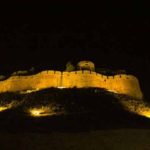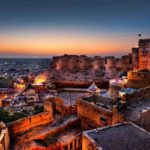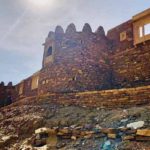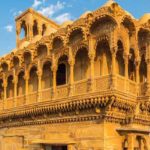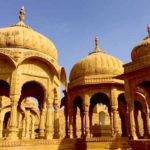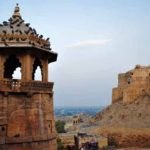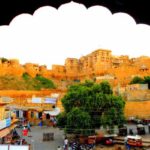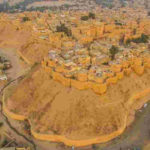Best Tourist Spot in Jaisalmer, known as the “Golden City,” is a gem in Rajasthan’s desert landscape. The best tourist spot in Jaisalmer is undoubtedly the Jaisalmer Fort, also known as Sonar Quila or the Golden Fort. Built in 1156 AD by Rawal Jaisal, the fort stands majestically on Trikuta Hill, overlooking the city with its massive sandstone walls glowing golden in the sunlight. Unlike any other fort in India, Jaisalmer Fort is a living fort, housing a quarter of the city’s population within its ancient walls.
Exploring the fort, visitors can marvel at its intricate latticework, vibrant bazaars, and historic palaces such as the Maharaja’s Palace. The fort also contains seven beautifully carved Jain temples, dating from the 12th to 15th centuries, showcasing exquisite craftsmanship.
Beyond the fort, the Sam Sand Dunes offer a captivating desert experience. Located about 40 kilometers from the city, these dunes provide opportunities for camel rides, desert safaris, and witnessing stunning sunsets. The annual Desert Festival, held in February, is a cultural extravaganza celebrating Rajasthan’s heritage with music, dance, and traditional competitions.
Jaisalmer’s unique blend of history, culture, and natural beauty makes it an unforgettable destination for travelers.
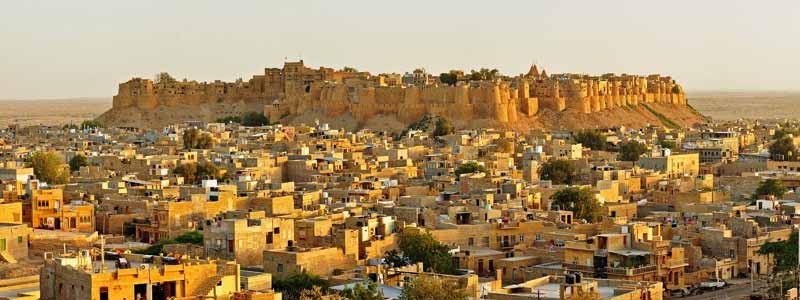
Jaisalmer Fort (Sonar Quila)
Description: A UNESCO World Heritage Site, this fort is one of the largest fully preserved fortified cities in the world. It houses several palaces, temples, and havelis.
Highlights: Raj Mahal, Laxminath Temple, and Jain Temples.
Jaisalmer Fort, also known as Sonar Quila or the Golden Fort, is a magnificent fortification that stands majestically in the heart of Jaisalmer, Rajasthan. Built in 1156 AD by Rawal Jaisal, the fort is a UNESCO World Heritage Site and one of the largest fully preserved fortified cities in the world. It is renowned for its yellow sandstone walls that gleam golden under the sun, giving it the name “Sonar Quila.”
The fort’s architecture is a blend of Rajput and Islamic styles, featuring grand gateways, narrow winding lanes, and intricately carved structures. Within the fort, the Raj Mahal (Royal Palace) offers a glimpse into the opulent lifestyle of the erstwhile rulers. The seven beautifully carved Jain temples, dating from the 12th to the 15th centuries, are also located inside the fort and are a testament to the exquisite craftsmanship of the era.
Jaisalmer Fort is not just a historical monument but a living fort, with a significant population residing within its walls. The bustling markets inside the fort sell a variety of traditional Rajasthani handicrafts, textiles, and jewelry, providing visitors with a unique cultural experience. The fort’s rich history, architectural splendor, and vibrant culture make it a must-visit destination for travelers exploring Jaisalmer.
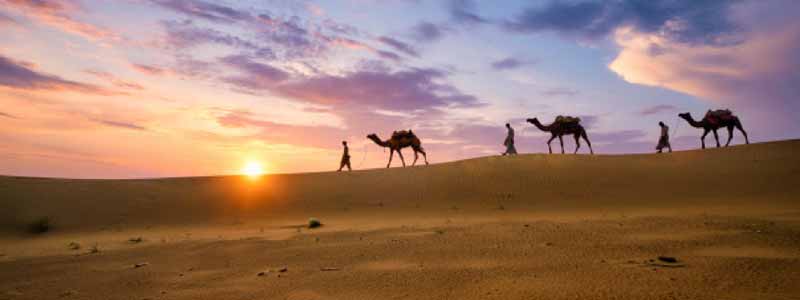
Sam Sand Dunes
Description: Located about 40 km from Jaisalmer, the Sam Sand Dunes offer a true desert experience with camel rides, desert camping, and cultural performances.
Highlights: Sunset views, dune bashing, and traditional Rajasthani folk music and dance.
Sam Sand Dunes, located about 40 kilometers from Jaisalmer, offer an enchanting desert experience that epitomizes the beauty and allure of the Thar Desert. These picturesque dunes are one of the most popular tourist destinations in Rajasthan, attracting visitors with their mesmerizing landscapes and opportunities for adventure.
At Sam Sand Dunes, the undulating dunes stretch as far as the eye can see, creating a stunning backdrop for various activities. One of the most iconic experiences is the camel safari, where visitors can traverse the sandy terrain atop a camel, immersing themselves in the desert’s serene ambiance. For those seeking more excitement, jeep safaris provide a thrilling ride over the dunes.
The best time to visit Sam Sand Dunes is during sunset, when the golden sands reflect the changing colors of the sky, creating a breathtaking panorama. Evening cultural programs often accompany the sunsets, featuring traditional Rajasthani music, dance performances, and local cuisine, offering a rich cultural immersion.
For a truly memorable experience, many tourists opt to stay overnight in desert camps. These camps provide comfortable accommodations and the opportunity to stargaze under the clear desert sky, far from the hustle and bustle of city life. Sam Sand Dunes’ natural beauty, combined with its cultural and adventure offerings, make it an unmissable highlight of any visit to Jaisalmer.
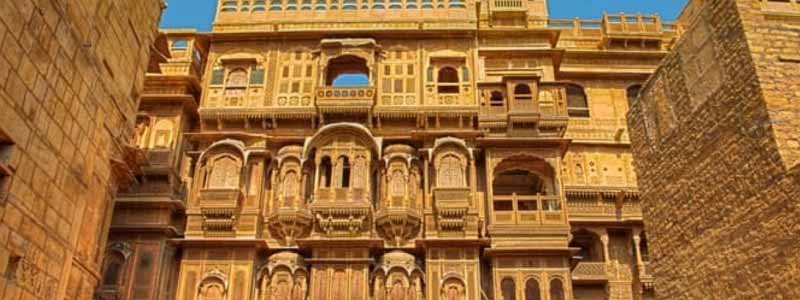
Patwon Ki Haveli
Description: A collection of five havelis built by a wealthy trader. It is known for its intricate architecture and detailed carvings.
Highlights: Exquisite mirror work, paintings, and elegant archways.
Patwon Ki Haveli is one of the most exquisite and intricately designed havelis in Jaisalmer, Rajasthan. Constructed between 1805 and 1860, this architectural marvel is a collection of five havelis built by Guman Chand Patwa, a wealthy trader, and his sons. It stands as a testament to the opulence and artistry of the time, reflecting the grandeur of Rajasthan’s rich cultural heritage.
The haveli is renowned for its stunning architecture, featuring intricate carvings, detailed jharokhas (overhanging enclosed balconies), and ornate facades. Each of the five havelis has its own unique design, yet they are harmoniously integrated into a single complex. The intricate stonework and elaborate balconies are a sight to behold, showcasing the exceptional craftsmanship of the artisans of that era.
Inside, Patwon Ki Haveli is equally impressive with its lavishly decorated rooms, wall paintings, mirror work, and beautifully crafted ceilings. The haveli also houses a museum that provides insights into the lifestyle of the Patwas, displaying artifacts, antiques, and furniture from the 19th century. Visitors can explore the maze of rooms, courtyards, and corridors, each offering a glimpse into the rich history and culture of Jaisalmer.
Patwon Ki Haveli is not just a historical monument; it is a living museum that offers a fascinating journey into the past, making it an essential visit for anyone exploring the Golden City.
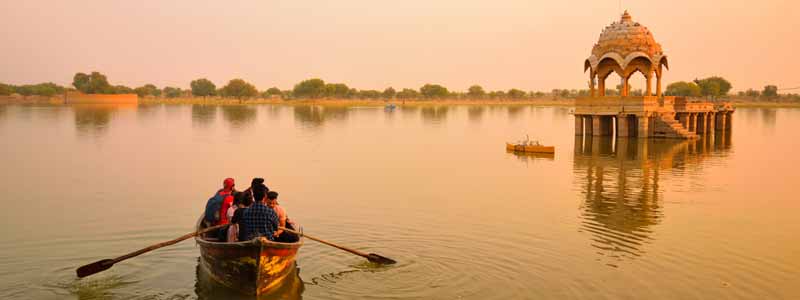
Gadisar Lake
Description: An artificial lake built by Maharaja Gadsi Singh. It’s a scenic spot surrounded by temples, ghats, and shrines.
Highlights: Boating, migratory bird watching, and the picturesque sunset.
Gadisar Lake is a serene and picturesque man-made reservoir located in Jaisalmer, Rajasthan. Originally constructed in the 14th century by Maharawal Gadsi Singh, the lake was designed to provide water to the city of Jaisalmer and has since become a popular spot for both locals and tourists seeking tranquility and natural beauty.
The lake is surrounded by a series of ornate temples, cenotaphs (chhatris), and ghats, which add to its charm and historical significance. The architecture around the lake reflects traditional Rajasthani craftsmanship, with intricately carved stonework and beautifully designed structures.
Visitors to Gadisar Lake can enjoy a leisurely boat ride on the calm waters, providing a peaceful escape from the city’s bustle and offering stunning views of the surrounding landscape. The lake is especially picturesque during sunset, when the golden light casts a warm glow over the water and the surrounding monuments, creating a breathtaking scene.
Gadisar Lake is also known for its rich birdlife, making it a great spot for birdwatching, particularly in the early morning or late afternoon. The lake’s serene ambiance, combined with its historical and cultural significance, makes it a must-visit attraction in Jaisalmer.
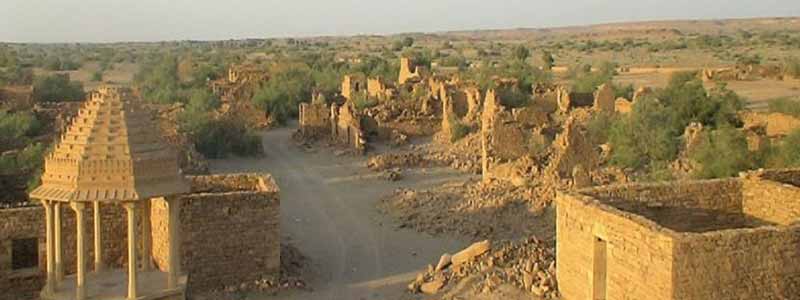
Kuldhara Village
Description: An abandoned village that dates back to the 13th century. Legend says the villagers left the village overnight due to mysterious reasons.
Highlights: Historical ruins and the eerie, abandoned atmosphere.
Kuldhara Village is a fascinating and historic abandoned settlement located about 20 kilometers southwest of Jaisalmer, Rajasthan. Founded in the 13th century by the Paliwal Brahmins, Kuldhara was once a prosperous village known for its advanced architecture and well-planned layout.
The village is renowned for its eerie, yet captivating, deserted streets and ruins. The legend behind its abandonment adds to its mystique: it is said that the village was cursed by its inhabitants when they were forced to leave due to the demands of a local ruler. According to local lore, the curse was so potent that no one has been able to resettle the village since.
Despite its desolate state, Kuldhara features impressive ruins, including well-preserved havelis, temples, and homes. The stone architecture, with its intricate carvings and traditional Rajasthani design, reflects the village’s former grandeur. Visitors can explore the labyrinthine alleys and structures, which offer a glimpse into the village’s past life and provide a unique experience of Rajasthan’s history.
Kuldhara Village is often visited for its hauntingly beautiful atmosphere, cultural significance, and the sense of mystery that surrounds it. It is an ideal destination for those interested in history, architecture, and the legends of Rajasthan.
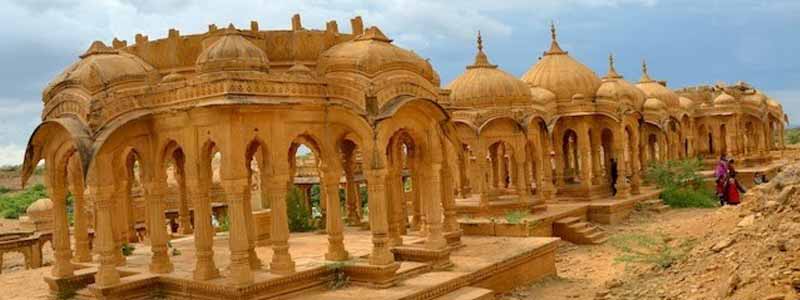
Bada Bagh
Description: A garden complex housing royal cenotaphs (chhatris) of the Maharajas of Jaisalmer.
Highlights: Stunning cenotaphs, scenic views, and photography opportunities.
Bada Bagh, located about 6 kilometers north of Jaisalmer, Rajasthan, is a historic site renowned for its majestic cenotaphs (chhatris) dedicated to the royal family of Jaisalmer. Established in the 16th century by Maharawal Jai Singh II, Bada Bagh served as a royal cremation ground and a memorial site for the rulers and their families.
The site is characterized by a series of intricately carved cenotaphs, each dedicated to a different king or queen. These cenotaphs are beautifully adorned with elaborate carvings and detailed artwork, reflecting the grandeur and artistic sensibilities of the time. The architecture of Bada Bagh is notable for its detailed stonework, with each chhatri featuring ornate domes, pillars, and arches.
Bada Bagh also offers panoramic views of the surrounding desert landscape, providing a serene and picturesque setting. The site is particularly captivating at sunset, when the golden hues of the setting sun cast a warm glow over the cenotaphs and the surrounding desert, creating a stunning and tranquil atmosphere.
Visitors to Bada Bagh can explore the cenotaphs and gain insights into the royal heritage of Jaisalmer. The site is a testament to the rich history and architectural brilliance of the region, making it a worthwhile stop for anyone exploring the cultural and historical landmarks of Jaisalmer.
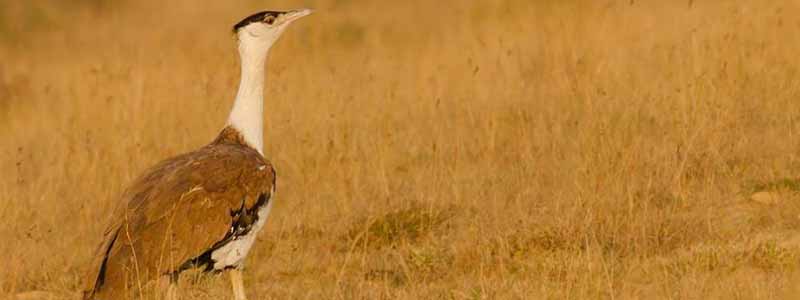
Desert National Park
Description: One of the largest national parks, it showcases the ecosystem of the Thar Desert with a variety of flora and fauna.
Highlights: Great Indian Bustard sightings, desert wildlife, and fossil remains.
Desert National Park, located about 40 kilometers southeast of Jaisalmer, Rajasthan, is a vast and unique protected area that spans over 3,000 square kilometers. Established in 1980, the park is one of the largest national parks in India and showcases the diverse flora and fauna of the Thar Desert.
The park is characterized by its arid landscape, featuring sand dunes, rocky outcrops, and salt flats. Despite the harsh conditions, Desert National Park is home to a variety of wildlife adapted to desert life. Notable inhabitants include the endangered Great Indian Bustard, a large bird known for its impressive size and elaborate courtship displays. The park is also a haven for other bird species, including eagles, hawks, and desert sparrows.
In addition to its avian residents, the park supports a range of mammals such as the Indian Fox, Desert Cat, and Blackbuck. The unique desert ecosystem is also home to various reptiles and insects.
Desert National Park offers opportunities for wildlife enthusiasts and nature lovers to experience the beauty of the desert landscape and observe its wildlife. Guided safaris and jeep tours are available, allowing visitors to explore the park’s diverse habitats and learn about the adaptations of desert flora and fauna. The park’s stark beauty, coupled with its rich biodiversity, makes it a captivating destination for those interested in India’s desert ecosystem.
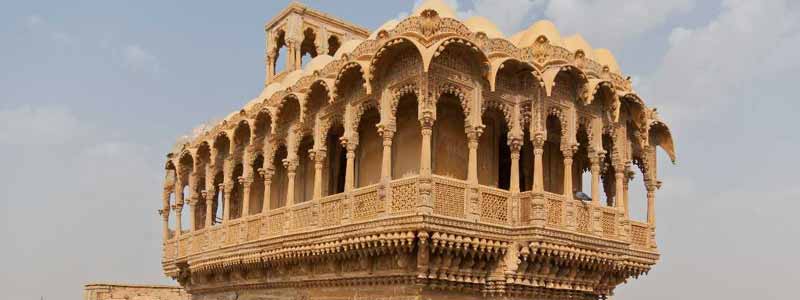
Salim Singh Ki Haveli
Description: A striking haveli built in the 17th century, famous for its unique architecture and peacock-shaped roof.
Highlights: Distinctive architecture, intricate carvings, and historical significance.
Salim Singh Ki Haveli, also known as Salim Singh Ki Haveli, is a historic mansion located in Jaisalmer, Rajasthan. Built in the late 19th century by Salim Singh, a wealthy merchant and the Prime Minister of Jaisalmer, the haveli is renowned for its distinctive architecture and ornate design.
The haveli stands out with its unique appearance, featuring a curved roofline that resembles a peacock’s tail, symbolizing the peacock’s association with grace and beauty. Its façade is adorned with intricately carved wooden balconies and jharokhas (overhanging enclosed balconies), showcasing exquisite craftsmanship. The intricate carvings and detailed artwork on the haveli’s walls, doors, and windows reflect the artistic and architectural sensibilities of the time Best Tourist Spot in Jaisalmer.
Salim Singh Ki Haveli is notable for its vibrant and colorful interior, which includes beautifully decorated rooms with ornate ceilings and carved wooden panels. The haveli’s design reflects the opulence and grandeur of the merchant’s wealth and status.
Visitors to Salim Singh Ki Haveli can explore its various rooms and courtyards, gaining insight into the lifestyle and architecture of the period. The haveli’s rich history, combined with its architectural beauty, makes it an important cultural and historical landmark in Jaisalmer.
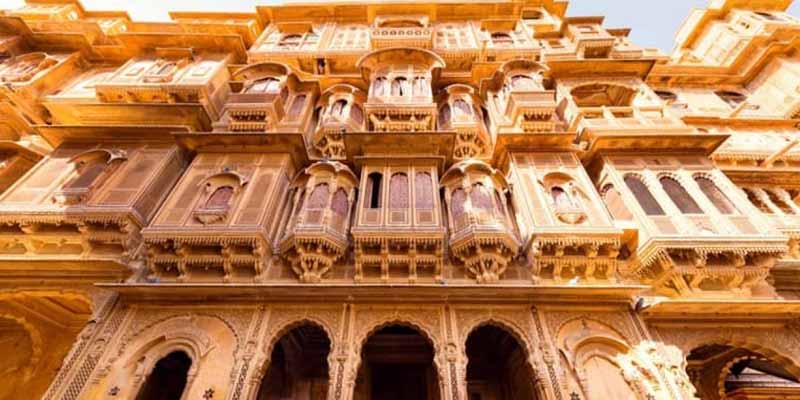
Nathmal Ki Haveli
Description: A 19th-century haveli built by two brothers with a blend of Rajput and Islamic architecture.
Highlights: Detailed facades, elephant carvings, and luxurious interiors.
Nathmal Ki Haveli is a stunning example of traditional Rajasthani architecture, located in the heart of Jaisalmer, Rajasthan. Built in the late 19th century by two brothers, Hiralal and Lalchand, who were prime ministers under the rule of the then Maharawal of Jaisalmer, the haveli is known for its intricate and elaborate design, Best Tourist Spot in Jaisalmer.
The haveli is famous for its unique and ornate carvings, including detailed stonework, beautifully crafted arches, and exquisite jharokhas (overhanging enclosed balconies). The façade of Nathmal Ki Haveli features a captivating blend of traditional Rajasthani and Islamic architectural elements, with an abundance of decorative motifs and patterns.
One of the most notable aspects of Nathmal Ki Haveli is its symmetrical design. The haveli was constructed by two brothers, each working on a separate side, leading to a fascinating, albeit slightly asymmetrical, harmony in the design. This unique construction method resulted in a beautiful interplay of architectural elements.
Inside, the haveli boasts richly decorated rooms, with elaborately painted ceilings, carved wooden doors, and intricate mirror work. The interior design reflects the opulence and grandeur of the era in which it was built.
Nathmal Ki Haveli’s architectural elegance and historical significance make it a must-visit attraction in Jaisalmer, offering visitors a glimpse into the artistic and cultural heritage of the region.
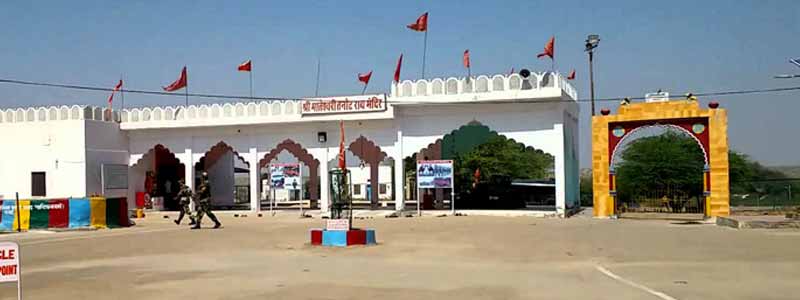
Tanot Mata Temple
Description: Located near the Indo-Pak border, this temple is known for its miraculous history during the Indo-Pak war.
Highlights: Devotional significance and historical anecdotes.
Tanot Mata Temple is a revered Hindu temple located in Tanot, a small village in the Thar Desert near the India-Pakistan border, approximately 120 kilometers from Jaisalmer, Rajasthan. The temple is dedicated to Tanot Mata, a local deity believed to be a form of the goddess Hinglaj Mata, who is worshipped for protection and blessings.
The temple is notable for its association with the 1965 Indo-Pakistani War. During the conflict, the area around Tanot was heavily shelled by Pakistani forces, but the temple and its surroundings were reportedly untouched by the bombs. This miraculous preservation of the temple has led to the belief that Tanot Mata protected the area and its people from harm. As a result, the temple has become a symbol of divine intervention and protection.
The temple’s architecture is traditional and modest, featuring simple yet elegant designs typical of rural temples in Rajasthan. Pilgrims and visitors come to Tanot Mata Temple not only for its spiritual significance but also for the historical and cultural context.
In addition to its religious importance, the temple is situated in a picturesque desert setting, offering a serene and contemplative environment. Visitors can explore the nearby desert landscapes and learn about the temple’s unique role during the 1965 war. The temple is a significant site for those interested in both religious and historical aspects of the region Best Tourist Spot in Jaisalmer.

